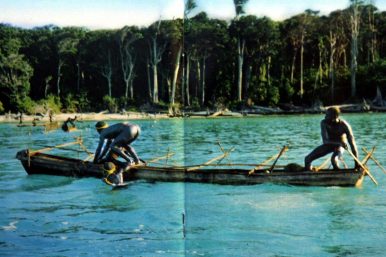By Sudha Ramachandran
 India’s plans for “development” on the Andaman and Nicobar Islands are threatening the survival of the archipelago’s already endangered indigenous populations. One of the projects that has been approved for implementation in the archipelago is a railway line linking Port Blair, the capital of the island chain, with Diglipur, the largest town on North Andaman Island. The 240-kilometer-long railway line will cut through a protected forest reserve where the native Jarawa live. This would increase the exposure of the Jarawa to outsiders – mainly non-tribal settlers and tourists – and impact their culture, health, and way of life, even their survival as a group.
India’s plans for “development” on the Andaman and Nicobar Islands are threatening the survival of the archipelago’s already endangered indigenous populations. One of the projects that has been approved for implementation in the archipelago is a railway line linking Port Blair, the capital of the island chain, with Diglipur, the largest town on North Andaman Island. The 240-kilometer-long railway line will cut through a protected forest reserve where the native Jarawa live. This would increase the exposure of the Jarawa to outsiders – mainly non-tribal settlers and tourists – and impact their culture, health, and way of life, even their survival as a group.
The railway is “a harebrained idea,” Manish Chandi, who works in the Andaman and Nicobar Islands on the interface between communities and the natural environment, told The Diplomat. The rail project, he said, will “cut swathes of otherwise untouched habitats,” as well as “the watersheds and drainage of the region and even beyond the Jarawa Reserve” to impact areas where the settlers live.
An archipelago of 572 islands, of which only 38 are inhabited, the Andaman and Nicobar Islands lie to the east of the Indian mainland in the Bay of Bengal. The southernmost islands are located near the mouth of the Strait of Malacca, while the northern islands are just a few nautical miles from Myanmar; this location gives the island chain immense strategic value. Not surprisingly, India is building up its military infrastructure there. Importantly, the island chain is home to India’s only tri-services theater command.
The archipelago is a tourist destination too, renowned for its turquoise blue waters and pristine beaches.
Less known is the fact that this stunningly beautiful and strategic archipelago’s indigenous people are sinking under a multitude of problems.
No comments:
Post a Comment